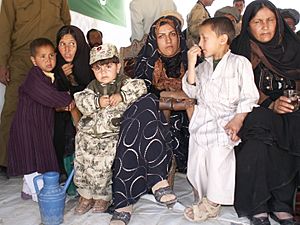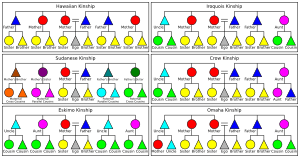Kinship facts for kids
Kinship is how people are related to each other. It's a way to organize individuals into social groups. The most common type of kinship is belonging to the same family by birth.
Contents
Understanding Kinship Connections
Kinship helps us understand how we are connected to our family. These connections can be through biology or shared history. Kinship is a system that exists everywhere. Everyone has a family, so everyone has kinship. In some societies, kinship is not just about family. It also helps with things like trade, government, and even religious beliefs.
The History of Kinship Studies
The study of kinship began with an anthropologist named Lewis H. Morgan. In the 1850s and 1860s, he studied the Iroquois. They are a Native American group in the Northeastern United States. Morgan wanted to understand what held societies together. He was the first to describe different types of kinship systems. He wrote about them in his book, 'Systems of Consanguinity and Affinity of the Human Family'.
Main Types of Kinship
There are two main ways people can be related through kinship.
Kinship by Blood: Consanguinity
Consanguinity means being related by blood. This includes your parents, siblings, and children. Laws in some countries use consanguinity. For example, they might decide who can get married. It can also help decide who inherits property if someone dies without a will. Many religions also use consanguinity to set rules for their followers.
Kinship by Social Ties: Affinity
Affinity means being related through social actions. This includes things like marriage or adoption. When you marry, your spouse's family becomes your family by affinity. Adopted children become part of a family through affinity. There are also legal and religious rules for these types of relationships.
How Descent Works
Descent explains how family lines are traced. There are two main types of descent.
Patrilineal Descent
Patrilineal descent means tracing your family connections through your father's side. This includes your father, his father (your grandfather), and so on. In some cultures, family names and property pass down through the male line.
Matrilineal Descent
Matrilineal descent means tracing your family connections through your mother's side. This includes your mother, her mother (your grandmother), and so on. In some societies, property or important roles are passed down through the female line.
Common Kinship Examples
Here are some common family relationships:
- parent (father or mother)
- child (son or daughter)
- sibling (brother or sister)
- grandparent (grandfather or grandmother)
- grandchild (grandson or granddaughter)
- uncle or aunt
- nephew or niece
- cousin
- ancestor (someone you are descended from, like a great-grandparent)
- descendant (someone who comes from you, like a grandchild)
Images for kids
-
A multi-generational extended family of Eastern Orthodox priest in Jerusalem, circa 1893
-
A mention of "cȳnne" (kinsmen) in the Beowulf
-
An illustration of the bi-relational and tri-relational senses of nakurrng in Bininj Gun-Wok.
See also
 In Spanish: Parentesco para niños
In Spanish: Parentesco para niños







